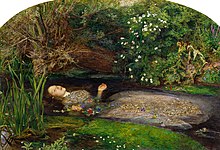
William Morris was a renowned poet, designer, weaver, and manufacturer of the late 19th Century. His work set a precedent for the Arts & Crafts Movement. He was born on March 24th, 1834 to an upper-middle class family at Elm House. Elm House was a country house in Walthamstow, East London, on the edge of Epping forest where Morris would explore as a child. William Morris Sr. was a successful city stockbroker who was able to afford the young Morris a privileged upbringing. In his childhood, William Morris became impassioned with the medieval era in reading knight's tales and from his time in church. He carried this passion with him his entire life. At the age of 17 he went with his family to the Great Exhibition of London (1851), an enormous and densely packed display of the works of industrial production and ingenuity. Perturbed by the mentality and lack of craft he witnessed there, Morris refused to continue touring the exhibits, which he said were only wonderful in that they were "wonderfully ugly".

In 1853 Morris departed to Oxford to study theology at Exeter College, vaguely intending to become a high church clergymen. At Exeter College, Morris met Edward Burne-Jones, who would become a painter, designer, and life-long friend to Morris. At Oxford Morris diverted from his idealistic notions of working for social reform through church ministry and began to attend to artistic pursuits such as writing poems and stories. After spending a summer vacation touring Northern France with Burne-Jones, visiting 9 cathedrals and 24 churches, Morris decided he would study architecture.
Morris and Burne-Jones moved to London where they befriended and joined the circle of Pre-Raphaelite painter and poet Dante Gabriel Rosetti. In 1856 Morris worked in the office of Gothic Revival architect George Edmund Street. In Street's office he met Philip Webb who had been in Street's office since 1854.
Rosetti met Jane Morris, a local girl from a very poor family, who was attending a play at the Drury Lane Theatre Company with her sister. Rosetti hired Jane as one of his models. From this connection Jane went on to model for Morris to whom she would be engaged. Their union provided the impetus for the Red House which Morris designed with Webb. As a model Jane would come to be regarded as the embodiment of the Pre-Raphaelite ideal of beauty. In the course of her married life she had multiple affairs including the longest with Rosetti. Jane confesses to never have been in love with Morris. At the time of Morris' proposal she was 18, in awe of his admiration and the promise of a comfortable life for herself and her family, she accepted. On April 26th, 1859 she and Morris were married.
.jpg)

During a river trip with friends on the 21st of August 1858, Morris and Webb began a discussion that would lead to the Red House. On the back of one of their maps, Webb made a preliminary sketch of the staircase in the Red House. By May of 1859, Webb had completed the designs for the Red House. In June of 1860 Morris and Jane Moved into the Red House in Bexleyheath Kent. The Red House fostered the development of Morris & Co. which began when Morris could not find furniture to suit his home, and began to craft his own. At the Red House Morris wrote "The Earthly Paradise", a volume of poetry which would quickly make him famous. In 1856, Morris moved to Kelmscott Manor, the headquarters of Morris & Co., since he could not make the commute to work to the Red House when he was sick.
Social and political convictions merged with aesthetic issues for Morris; in the late 1870's, he became involved with the socialist cause. To Morris, his role as a social reformer was a clear continuation of his work as an arts and crafts designer and producer.
Morris died peacefully, on October 3rd 1986 at Kelmscott Manor, following a long bout of illness. His physician declared his cause of death as "simply being William Morris and having done more work than most ten men".
Jane Morris commissioned Webb to design The Morris Cottages which were completed in 1902 in memory of her former husband.
---------
Citation:
"William Morris – Artist, Philosopher, Poet and Designer." William Morris.
http://www.william-morris.co.uk/Morris%20History.pdf.
"William Morris: a brief biography." Literary Places. Accessed December 11, 2012.
http://www.literaryplaces.co.uk/?page_id=1177.
Harvey, Charles. "William Morris: Design and Enterprise in Victorian Britain."
http://books.google.ca/
books?id=ujXpAAAAIAAJ&pg=PA6&lpg=PA6&dq=emma+shelton+william+morris&source=bl&ots=VB4gl4qbFi&sig=ruQt
OdVuMf5JtT3oRv543xSQgBc&hl=en&sa=X&ei=T9jEUJzbMeLkygGuw4GgBg&ved=0CEUQ6AEwBA#v=onepage&q=emma%20shelt
on%20william%20morris&f=false.
"William Morris - Life and painting career." Archives and Rare Books Library. Accessed December 9,
2012. http://www.libraries.uc.edu/libraries/arb/exhibits/William%20Morris/life_career.html.
"William Morris and his circle." Harry Ransom Center. Accessed December 8, 2012.
http://www.hrc.utexas.edu/exhibitions/web/morris/.










.jpg)


.jpg)





